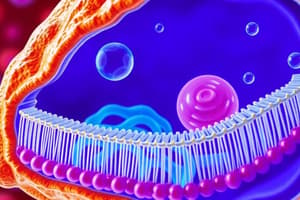Podcast
Questions and Answers
What is the primary function of the cell membrane?
What is the primary function of the cell membrane?
- Conducts photosynthesis
- Regulates the passage of substances in and out of the cell (correct)
- Synthesizes proteins
- Stores genetic information
Which organelles are primarily involved in energy production within the cell?
Which organelles are primarily involved in energy production within the cell?
- Mitochondria and chloroplasts (correct)
- Ribosomes and Golgi apparatus
- Nucleus and endoplasmic reticulum
- Lysosomes and peroxisomes
How do chloroplasts and mitochondria interact to support the life processes of a plant cell?
How do chloroplasts and mitochondria interact to support the life processes of a plant cell?
- Mitochondria synthesize chlorophyll for chloroplasts
- Mitochondria store solar energy absorbed by chloroplasts
- Chloroplasts create glucose which mitochondria use for energy production (correct)
- Chloroplasts expel carbon dioxide used by mitochondria
What nutrients do cells primarily need to grow and reproduce?
What nutrients do cells primarily need to grow and reproduce?
What is the importance of the interactions between cell structures?
What is the importance of the interactions between cell structures?
Flashcards are hidden until you start studying
Study Notes
Cell Structures and Their Functions
- Cell structures, or organelles, each have unique functions essential for cell operation.
- The nucleus controls cellular activities by storing DNA and regulating gene expression.
- Mitochondria are the powerhouses, converting nutrients into energy through cellular respiration.
- Chloroplasts, found in plant cells, facilitate photosynthesis by capturing sunlight and converting it into chemical energy.
- The endoplasmic reticulum (ER) synthesizes proteins and lipids, while the Golgi apparatus modifies and packages them for transport.
- Lysosomes contain enzymes that digest cellular waste and recycle cellular components.
Interaction of Cell Structures
- The cell membrane regulates nutrient entry and waste exit, maintaining homeostasis.
- The cytoplasm is the medium where organelles are suspended and metabolic reactions occur.
- Mitochondria and chloroplasts work with the cytoplasm to convert and utilize energy effectively.
- Nutrient absorption occurs mainly through the cell membrane, while energy production is coordinated between mitochondria and chloroplasts.
Modeling Cell Interactions
- Visual models can depict organelles' spatial relationships and interactions in energy production and nutrient processing.
- Flow of nutrients from absorption, through the cytoplasm, to energy production occurs in a systematic manner.
- Processes like cellular respiration and photosynthesis can be illustrated to show how organelles support each other.
Importance of Interactions in Cellular Processes
- Continuous nutrient intake supports cell growth, reproduction, and functionality.
- Interaction between organelles ensures that cells can produce necessary materials and efficiently eliminate waste.
- The balance and cooperation between cell structures are vital for sustaining life, adapting to changes, and maintaining cellular health.
Studying That Suits You
Use AI to generate personalized quizzes and flashcards to suit your learning preferences.



